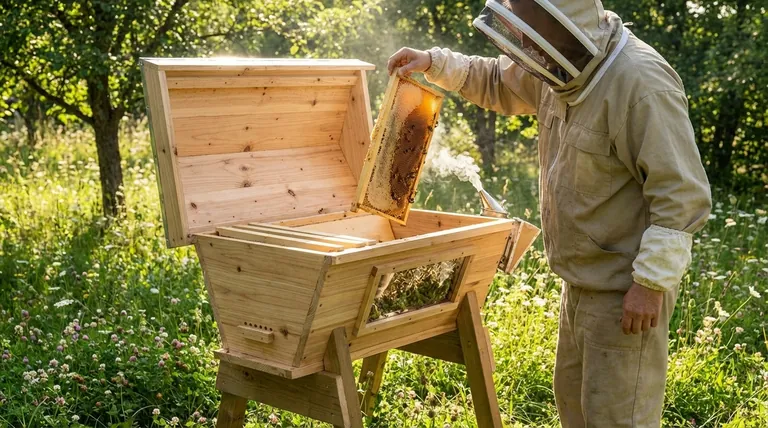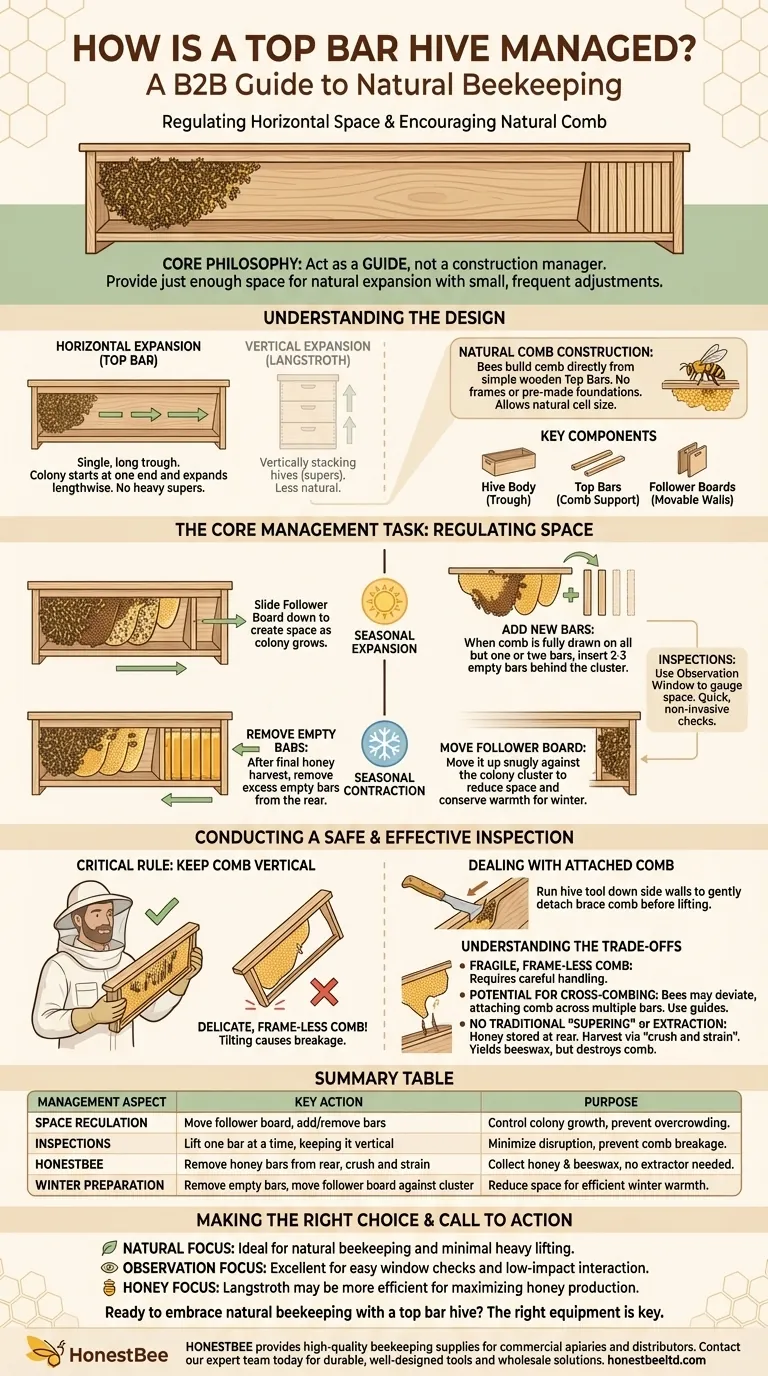At its core, managing a top bar hive is a process of regulating horizontal space. Unlike vertically stacking hives, you manage the colony's growth by moving a divider board and adding or removing individual bars within a single, long hive body. This encourages the bees' natural comb-building instincts while allowing for simple, frequent inspections.
The central philosophy of top bar hive management is to act as a guide, not a construction manager. Your primary role is to provide just enough space for the colony to expand naturally, making small, frequent adjustments rather than performing heavy, disruptive hive reorganizations.

Understanding the Top Bar Hive's Design
To manage a top bar hive effectively, you must first understand its unique, bee-centric design. It operates on principles that differ significantly from the more common, box-based Langstroth hive.
Horizontal vs. Vertical Expansion
The most defining feature is its horizontal structure. The hive is a single, long trough. The colony starts at one end and expands lengthwise toward the other.
You do not add heavy boxes ("supers") on top for honey. Instead, you give the bees more horizontal room by adding empty bars at the back of the cluster.
Natural Comb Construction
Bees build their comb directly down from the top bars, which are simple wooden strips. There are no four-sided frames or pre-made foundations.
This allows bees to build comb with the cell sizes they naturally prefer. Each top bar usually has a guide, like a beveled edge or a strip of wood, to encourage the bees to build straight down.
The Key Components
The hive is elegantly simple. Its management revolves around a few key parts: the hive body (the trough), the top bars (where comb is built), and one or more follower boards (movable walls used to adjust the colony's internal space).
The Core Management Task: Regulating Space
Your most frequent activity will be managing the space available to the bees. This ensures they have room to grow the brood nest and store honey without becoming overcrowded or wasting energy heating an oversized cavity.
The Role of the Follower Board
The follower board is a solid panel shaped like the hive's cross-section. It acts as a movable wall, defining the back end of the hive.
As the colony grows and fills combs with brood, pollen, and nectar, you slide the follower board down the hive to create more space.
When and How to Add New Bars
Inspections, often done quickly through an observation window, will show you how much empty comb the bees have left.
A good rule of thumb is to add more space when the bees have fully drawn out comb on all but one or two of the available bars. To expand, you simply slide the follower board back and insert two or three new, empty bars behind the last drawn comb.
Preparing for Winter
Management in the fall involves reversing the process. After the final honey harvest, you will remove any empty bars from the back of the hive.
You then move the follower board up snugly against the colony's cluster. This reduces the interior space, allowing the bees to more efficiently keep the cluster warm throughout the winter.
Conducting a Safe and Effective Inspection
Inspections in a top bar hive are less invasive than in other hive types because you only need to look at one comb at a time.
Using the Observation Window
Many top bar hives include a viewing window along one side. This is your most valuable tool for day-to-day management, as it allows you to gauge the colony's size and progress without opening the hive and disturbing the bees.
The Critical Rule: Keep the Comb Vertical
When you lift a bar for inspection, you are holding a delicate sheet of wax filled with honey or brood. It is not supported by a four-sided frame.
You must always keep the top bar oriented vertically, like a page in a book. Tilting it horizontally will cause the fragile comb to break off the bar under its own weight.
Dealing with Attached Comb
Bees will sometimes attach their comb to the slanted side walls of the hive. Before you can lift a bar, you must run your hive tool down the sides to gently detach this "brace comb."
Understanding the Trade-offs
The simplicity of the top bar hive comes with a distinct set of considerations that differ from other beekeeping methods.
Fragile, Frame-less Comb
The natural, frame-less comb is beautiful but delicate. Improper handling will lead to broken combs, which can be a significant setback for the colony and a messy problem for you.
Potential for Cross-Combing
If bees deviate from building on a single bar and attach comb across multiple bars, it creates a major problem. This "cross-comb" makes inspection impossible without destroying the comb. Using bars with clear guides and ensuring the hive is perfectly level helps prevent this.
No Traditional "Supering" or Extraction
Honey management is different. You do not add boxes (supers) for honey collection. Instead, honey is stored on bars at the rear of the hive, past the brood nest.
Harvesting involves removing these honey-filled bars and processing them via the "crush and strain" method, as the comb cannot be spun in a centrifugal extractor. This yields beeswax as a valuable byproduct but destroys the comb in the process.
Making the Right Choice for Your Goal
Deciding to use a top bar hive depends entirely on what you want to achieve with beekeeping.
- If your primary focus is natural beekeeping and minimal heavy lifting: This hive is an excellent choice, as it promotes natural comb and you only ever lift a single, manageable bar at a time.
- If your primary focus is maximizing honey production: A Langstroth hive may be more efficient due to its capacity for honey supers and compatibility with centrifugal extractors that preserve the comb.
- If your primary focus is observation and low-impact interaction: The top bar hive is ideal, offering easy window checks and a calm, bar-by-bar inspection process that is less disruptive to the colony.
Ultimately, managing a top bar hive is an exercise in partnership, guiding a colony's growth with frequent, gentle attention.
Summary Table:
| Management Aspect | Key Action | Purpose |
|---|---|---|
| Space Regulation | Move the follower board; add/remove bars | Control colony growth; prevent overcrowding |
| Inspections | Lift one bar at a time, keeping it vertical | Minimize disruption; prevent comb breakage |
| Honey Harvesting | Remove honey bars from the rear; use crush and strain | Collect honey and beeswax; no extractor needed |
| Winter Preparation | Remove empty bars; move follower board against the cluster | Reduce space for efficient winter warmth |
Ready to embrace natural beekeeping with a top bar hive? The right equipment is key to a successful and gentle beekeeping experience. At HONESTBEE, we supply high-quality beekeeping supplies and equipment to commercial apiaries and distributors. Let us provide you with the durable, well-designed tools you need for effective hive management. Contact our expert team today to discuss your wholesale needs and find the perfect solutions for your operation.
Visual Guide

Related Products
- Top Bar Beehive for Beekeeping Wholesales Kenya Top Bar Hive
- Long Langstroth Style Horizontal Top Bar Hive for Wholesale
- HONESTBEE Advanced Ergonomic Stainless Steel Hive Tool for Beekeeping
- Professional Hive Top Bee Feeder for Beekeeping
- HONESTBEE Round Hive Top Bee Feeder for Syrup
People Also Ask
- What are the advantages of harvesting honey from a top bar hive? Low-Cost, Simple Harvesting for Beekeepers
- Which is better Kenya top bar hive or Langstroth? Choose the Right Hive for Your Goals
- Why are hive inspections easier with Top Bar Hives? Achieve a Calmer, Safer Approach to Beekeeping
- What are the labor requirements for a KTBH vs. Langstroth hive? A Guide for Apiary Efficiency
- What are the key features of the Kenyan Top Bar Hive? A Guide to Simpler, Natural Beekeeping



















